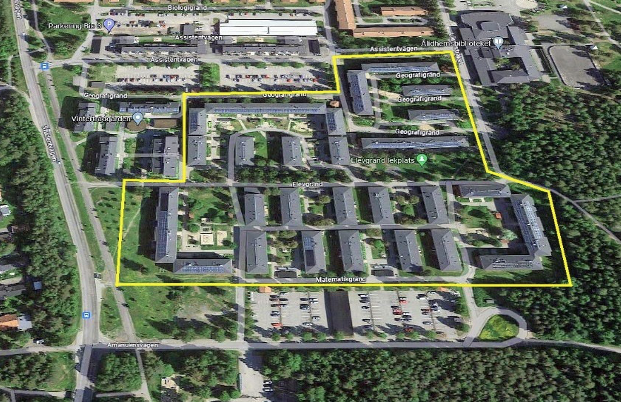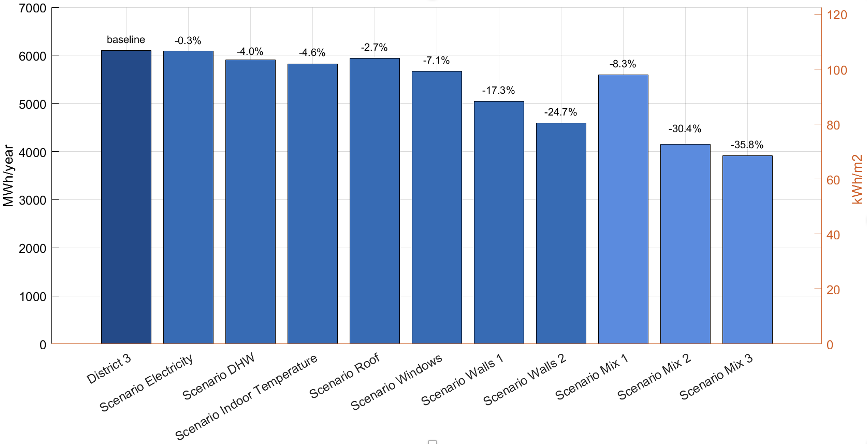Posted on: 10th March 2025

Note: This page provides a shortened summary of the extensive case study, which includes the research, the simulation and Matrix scoring results, as well as recommendations. For the whole document, simply click here and download as a .pdf file.
Introduction
Areas with northern climate, such as Sweden, face other challenges than the rest of Europe to create PEDs such as long, dark, and cold winters, which lead to a higher heating demand and well-insulated buildings, and the seasonal variations which influence solar production and energy demand.
Umeå Municipality is one of the 23 municipalities and six authorities in Sweden that have signed the Climate Contract 2030. Umeå’s goal is to become climate neutral for the urban city area by 2030 and for the whole of municipality by 2040. Umeå envision to reduce the climate impact from transport in two steps. By 2025 its goal is to increase the share of public transport, bycycle, and foot combined to be 65% of all residential trips. Further, switch to a fossil-free vehicle fleet by 2030.
Ålidhem which is the case district for this project is in south-eastern Umeå, close to the University and the University hospital and consists mainly of multi-residential buildings and student apartments. The buildings in Ålidhem were built in 1970/71 as part of the Swedish Million Programme.
The case study consists of 21 multi-family buildings in Ålidhem . The buildings were refurbished approximately a decade ago (2010-2014), and a package of energy efficiency measures were implemented in the buildings. One of the goals for the refurbishment project was that it should not be so costly that it would force the residents to move out from their apartments due to increased rents. A large share of the Swedish building stock is built during the Million Programme and are commonly associated with high energy use and poor indoor comfort. Thus, the case district might be representative for other neighborhoods built during the same period, and the insights from this study may be replicated in other areas.
2. Methodology of Research
Building properties were collected from literature and calculated from buildings blueprints using Bluebeam Revu®. Additional information, including electricity and domestic hot water (DHW) usage necessary for the modelling, was gathered from various studies and project reports. In instances where specific data was unavailable, Swedish and international standards, such as the Swedish guidelines for energy in buildings (SVEBY), were utilized to estimate parameters such as occupancy, seasonal variations in electricity and water use, freshwater consumption, and indoor temperature. Energy data for the pilot building, both pre- and post-renovation, as well as for the entire district post-renovation, was provided by Umeå Energy.
Local energy production
A solar cell plant was installed during the project, with a size of 2655m2 and the planned production was 350MWh. In 2015-16 the solar plant produced up to 317 MWh, corresponding to 6.5kWh/m2. The amount of produced electricity from the plant that was used within the buildings was up to 58%.
Input parameters
Daily energy data for one refurbished building and one reference building (remained the same) are available, and consists of electricity for the facilities and households, domestic hot water (DHW), energy bought for the air handling unit (AHU), heat for radiators and ventilation, and heat losses from tap water circulation. After the refurbishment, monthly data on electricity, space heating and DHW are available.
The buildings in the district have largely the same building properties since they were constructed during the Swedish million homes program in the late 1960s. All buildings are multi-residential buildings. Since the buildings have similar physical properties, the CEA model was suitable for upscaling from one single building to the entire district. Building properties such as height, number of floors and U-values for construction components were gathered from construction drawings. Other inputs were collected from Swedish and international standards.
Simulation results

In figure above, District 3 is considered as the baseline, which has an energy demand of 6107 MWh, which corresponds to 111.4 kWh/m2 with GFA 54816m2. The figure shows how various energy efficiency measures included in the study affect the performance of district. Wall insulation had the largest impact on energy performance, between 17.3% and 24.7% energy savings. Scenario Mix 1 (improved energy efficiency of appliances, lighting and an indoor temperature setting of 20 0C) can result in an energy use reduction of 8.3%, that corresponds to the specific final energy use reduction by 9.4 kWh/m2. Scenario Mix 2 and Scenario Mix 3, which is a combination of Scenario Mix 1 and energy efficiency improvement in envelope can provide an energy reduction of 30.4% (1856 MWh and 35.7 kWh/m2) and 35.8% (2186 MWh and 39.9 kWh/m2), respectively.
Local goals and engagement
At a local level, everyone who lives and work in Umeå should contribute by reducing the climate-impacting emissions. Greenhouse gas emissions from energy use per inhabitant in Umeå has been steadily decreasing since 1990, however as the population of Umeå is growing, the actual emissions have remained essentially the same since the 1990s. Umeå municipality will develop a new energy plan based on scenario analyses for Umeå’s future energy system. The PED-case study in Ålidhem could provide insignts into this.
One of the key partnerships in Umeå is the Umeå climate roadmap – Umeå’s local green deal. It brings together +50 organizations with a common goal, to contribute to reducing Umeå’s emissions in line with the Paris Agreement. Another important partnership is the collaboration with NZC through Umeå being part of the EU Mission: Climate-Neutral and Smart Cities. Furthermore, there is an ongoing partnership agreement between Umeå university and Umeå municipality.
In Umeå there is a network for sustainable construction and real estate management in cold climate (Nätverket för hållbart byggande och förvaltande I kallt klimat) which has members representing various parts of the whole building chain. This network organizes one day annual meetings and occasional breakfast meetings and provides a good forum for networking among the actors in this field.
To build a strong mandate engaging with citizens is important. Umeå has developed Umecom, which is a community-based initiative, aiming at fostering collaboration among citizens, businesses, associations, researchers, and the public sector to realize ideas that make Umeå a better place for all. The platform encourages cross-sectoral collaboration, allowing to support individuals with ideas and engagement in reducing climate impact and contributing to the sustainable development of Umeå. Umeå continue to build and develop strong partnerships to enable sustainable transition.
conclusions
Reducing the energy need in existing buildings is crucial in planning for positive energy, since the district should utilize the available local energy in the best way possible. Renovating existing districts, and especially in northern areas, holds specific challenges to PED implementation. For example, restrictions to physical refurbishment and the mismatch of solar production and energy demand during summer and winter months require consideration since they complicate PED realization. The available solar energy during winters is not enough to meet the energy demand, and since seasonal storages are yet in use, the district needs to import energy from the grid. In this study a calibrated urban building energy modelling for the case study area in Ålidhem is developed to evaluate energy renovation potential and its impact on energy demand and peak load. Further, solar energy production potential from roof top solar PVs in 21 buildings are also being investigated.
